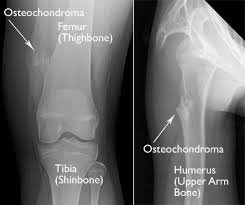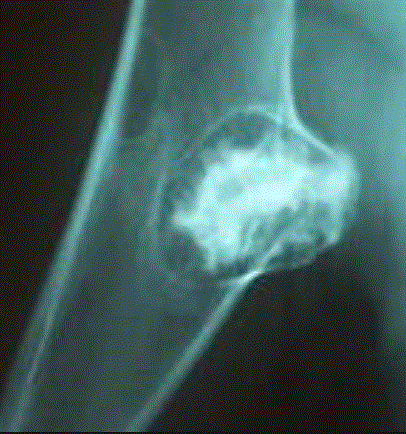What is Osteochondroma?
Osteochondroma is a tumor that develops on the surface of the bone close to the growth plate. It is a benign growth and can occur during childhood and puberty.4

In children, growth plates represent regions where the cartilage tissue develops at the end of long bones. The bone growth develops in the region of growth plate and when the child is fully mature, the growth plate becomes a solid bone.
Osteochondroma emanates from the growth plate and comprises of cartilage and bone. Osteochondroma may also grow in size and swell as long as the child continues to grow. This tumor will stop growing when the child is fully grown.
Types
Osteochondroma can occur as single or many tumors in the body. The following are types of osteochondroma:
Single Osteochondroma
This type of osteochondroma accounts for most of the benign bone growths. A non-cancerous bone tumor is not cancer and does not spread to other regions in your body.
Single osteochondroma occurs when the bone grows away from the growth plate against how it is supposed to be. This type of osteochondroma develops at the end of long bones where they come together to form joints. For example it is found in shoulder, hip and knees.
This tumor can have a stalk or stem that protrudes from the normal bone. If the overgrowth has a stalk, it is referred to as pedunculated. While it is called sessile if the tumor is fixed to the bone with a large base
The real cause of single osteochondroma is not yet known. However, researchers believe that it is caused by a defective gene referred to as EXT 1. Although this mutated gene is associated with the tumor, it is not yet understood how the gene contributes to formation of the osteochondroma.
Researchers are currently trying to investigate the link between the EXT 1 gene and osteochondroma.3
Symptoms
Many people with single osteochondroma show no signs and symptoms. However, the symptoms can appear after some time when the tumor is fully developed. The following are the signs and symptoms of single osteochondroma:
People with this tumor can notice bumps close to the joints especially on the shoulder and knees. These bumps are not painful.
Many people complain of pain while doing a certain activity. This tumor can develop below the tendon, which is a tissue that connects the muscle to the bone. When it forms there, the tendon is pushed over the growth causing pain.
Other people can experience weaknesses or numbness in affected areas. The bone growth can develop near a nerve especially at the back of your knee. This tumor can compresses the nerve leading to numbness in the associated parts of your body.
This tumor can disrupt blood flow in patients’ body. The presence of a tumor in the body can press on the blood vessels hence disrupting blood flow. This can result in loss of pulsation in your body.

Multiple Osteochondromatosis
It is also called diaphyseal aclasia, multiple hereditary exostosis or multiple hereditary osteochondromatosis. These tumors can develop in different places of your body and their numbers can also vary.
Just as single osteochondroma, sessile and pedunculated tumors can also develop in multiple osteochondromatosis. These tumors can lead to abnormal growth of bones in patients with the bone growths. In many cases, patients with multiple osteochondromatosis have abnormalities in their forearms and short size. Patients can have knees that touch each other when they straighten their legs.
Multiple osteochondromatosis affects men more than women. These tumors can become malignant than single osteochondroma 2
Causes
Multiple Osteochondromatosis are inherited tumors. Parents with mutated genes that cause multiple osteochondromatosis can pass a copy to their children.
The mutated genes called EXT are responsible for this disease just like in single osteochondroma.
Signs and symptoms of multiple osteochondromatosis are similar to those of single osteochondroma. However, these symptoms are very severe. Multiple osteochondromatosis can be very painful when the tumor exerts pressure on your blood vessels and nerves.
Diagnosis
Several tests can be conducted to identify osteochondroma. They include:
Physical test
Since many osteochondroma do not show symptoms, your doctor may ask your general health and any symptoms you are experiencing. Your doctor can check your bones for tenderness and also your range of movement in the affected places.
X-rays
Your doctor can conduct X-rays to show images of your bones which can be used to check for abnormalities in the bone structure.
Imaging scans
Your doctor can suggest magnetic resonance imaging (MRI) and computed tomography scans to help identify growths in soft tissues and bones. MRI scan can be used to check for problems in the cartilage.
Biopsy
A biopsy can be performed to check for cancer. In this test, your doctor removes a sample of bone growth by piercing a needle into the tumor. The sample is analyzed in the laboratory to determine if it is cancerous or not.4
Treatment
Once diagnosis has shown presence of osteochondroma, your doctor would want to monitor it closely for any abnormal changes. Your doctor would schedule regular X-rays to track changes of the growth.
The tumor can be removed if it indicates the following signs:
- It is painful
- It compresses the arteries and nerves
- It has formed a large cap of cartilage.1
Surgery
Your doctor can remove osteochondroma tumor through a surgery procedure referred to as excision. In this method, your doctor removes the tumor from the normal bone.
Chemotherapy
Your can use drugs to kill cancerous tumors in your body. These drugs stop the ability of the cancerous cells to grow and multiply.
Chemotherapy can be injected into yours veins or taken orally as pills. Usually chemotherapy requires several cycles of treatment in order to prevent cancer from spreading in your body.
Radiation therapy
In this method, your doctor uses powerful X-rays to destroy cancerous cells in your body. Depending on the size of the growth, your doctor can perform radiation therapy to shrink the tumor or stop it from spreading.
As for any tumor, regular screening is the best option to find out if the tumor is cancerous or not. Therefore when you suspect you have an abnormal bone growth, seek medical attention immediately to find out if it can cause cancer and how to prevent it.
Reference List
- Bone cancer treatment. http://www.cancer.net/cancer-types/bone-cancer/treatment-options
- http://orthoinfo.aaos.org/topic.cfm?topic=a00079
- Osteochondroma. http://www.hopkinsmedicine.org/healthlibrary/conditions/bone_disorders/osteochondroma_85,p00125/
- http://www.childrenshospital.org/conditions-and-treatments/conditions/osteochondroma-extosis/symptoms-and-causes
Similar Posts:
- Tumor Suppressor Genes
- Chondrosarcoma – Symptoms, Prognosis, Treatment, Survival Rate
- HER2 Positive Breast Cancer
- Genetic DNA Testing for Cancers
- Retinoblastoma
- Acute Myeloid Leukemia
- Ewing’s Sarcoma – Prognosis, Survival Rate, Symptoms, Treatment






Leave a Reply